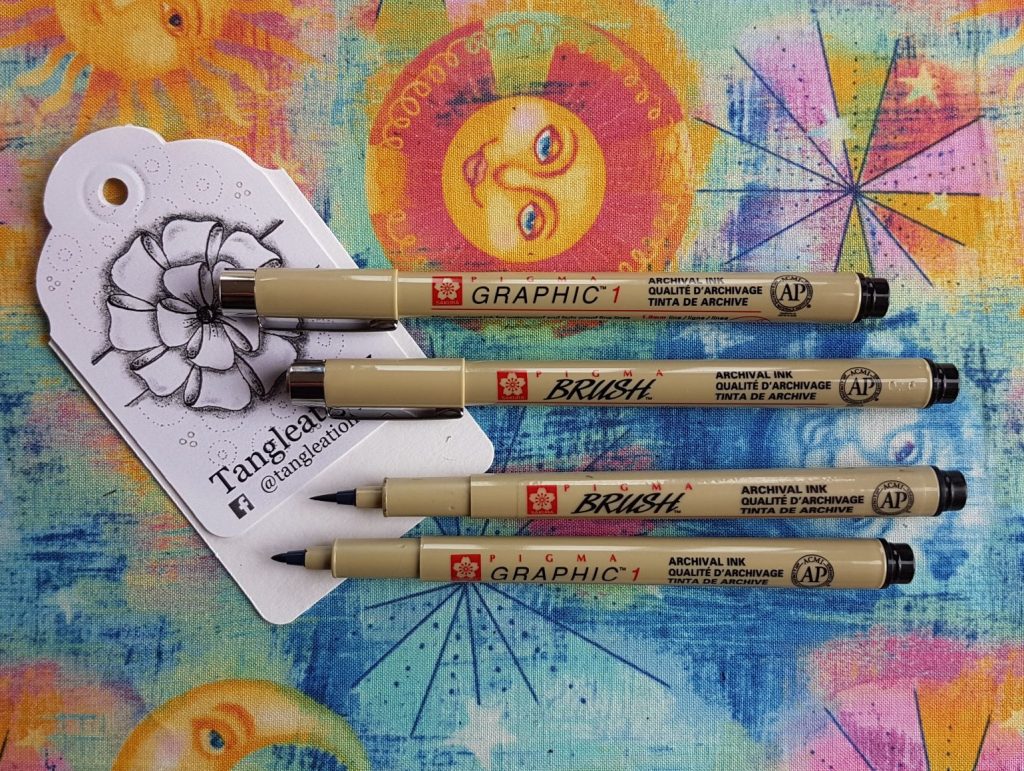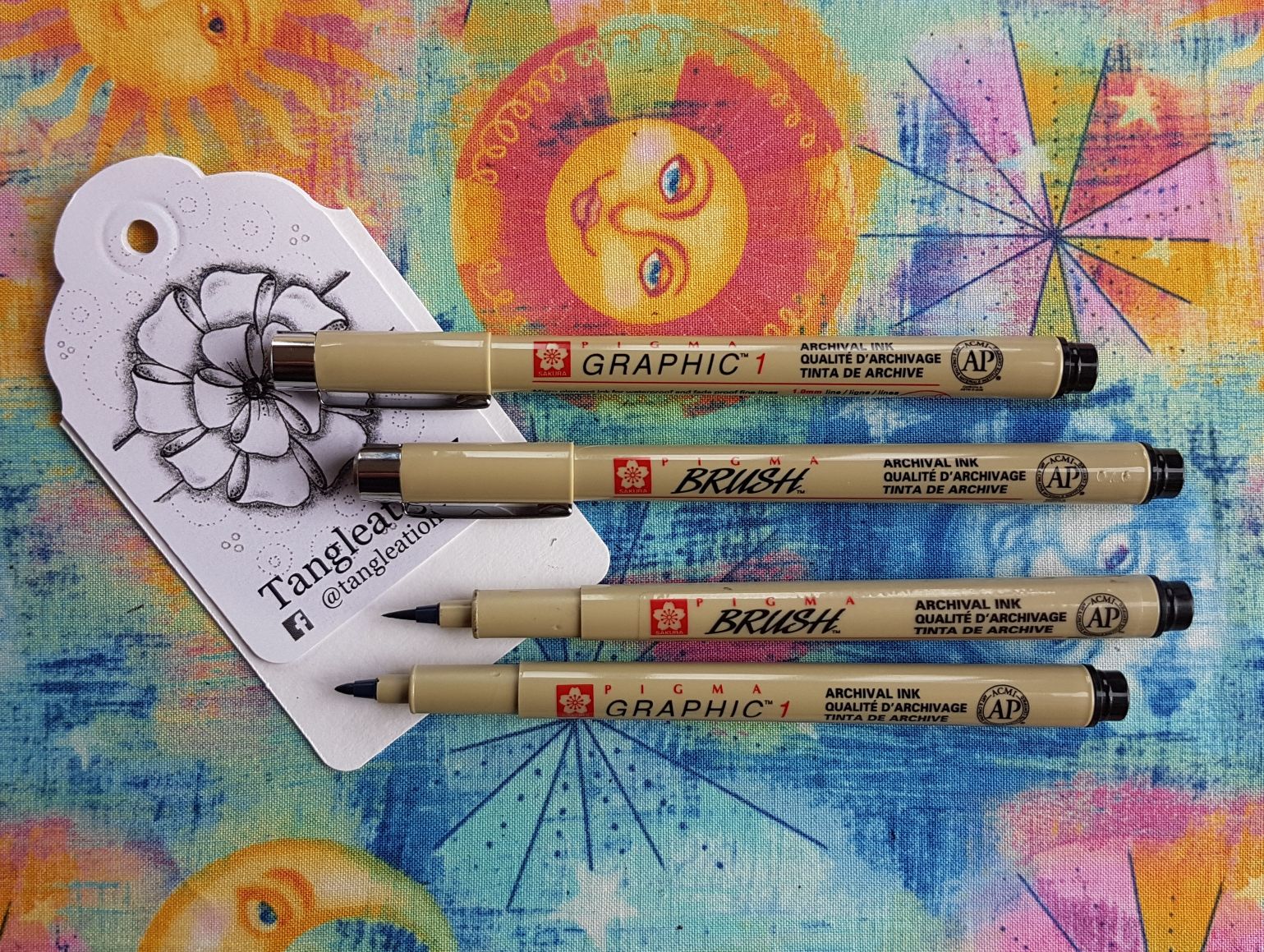
Thought it would be a little bit of fun to explain what exactly a ‘pigment’ ink is, and why it’s the best ink for tangling.
A little background – there are two types of colourant in ink – dye and pigment, and either of these two can be used in a carrier/binder, be that oil, solvent, water or a gel. Please note it’s not quite a simple recipe of two items, various things can be added like gelatin, lubricants, surfactants, solubilizers, resin, gum, shellac, soot – the list goes on!
Colourants
A ‘dye’ colourant has smaller colourant particles, is water soluble, and can make vivid bright colours. It’s cheaper than pigment inks, but doesn’t have the same fade resistance as a pigment.
A ‘pigment’ colourant has a larger particle size, they are waterproof, although may use water as its binder, but once dry won’t move. Although not as bright colours can be achieved, on most papers they will produce a sharper line, as the pigment tends to stay on the surface not bleed.
Small Note – Paper also matters, as a basic rule high ‘cotton’ based not ‘wood pulp’ based paper also helps stop bleed.
Binders
Oil-based – generally used in ballpoint pens, thick and sludgy, great for working on rough surfaces or glossy paper, but does take a wee while to dry on some surfaces – so don’t smear it, but it’s a cheap versatile ink, but often with limited colours.
Solvent-based – used in permanent markers (you know the type – they smell) – e.g. alcohol based pens, made with dye ink as they hold a more vibrant colour range.
Water-based – probably the most common – used in fountain pens (dye), for drawing pens (dye), Pigma Microns (pigment), India ink (pigment), calligraphy (pigment), rollerball pens (can be either pigment or dye, so check the label).
Gel-based – used with a large roller ball pen system but will normally use a pigment colourant, so will give a strong colour and smooth line. Excellent for working on porous surfaces (pigment will sit on top rather than bleed into the surface).
So what does all this mean from a tangling perspective?
Most well known fine liners are pigment based (Sakura’s Micron Pigma, Staedtler’s Pigment Liner, Copic’s Multiliner, Derwent’s Graphik). Using a pigment based ink will give a crisp non-bleeding line on most types of paper, and once it has dried, it won’t be moved, no matter what you put on it (which makes it an excellent thing to note when doing mixed media work). These pens are more expensive due to the pigment colourant, but they have a long life and are pretty fade resistant.
Where a fine felt pen might not be the best tool of choice is with a surface that lifts off, or other pen ink isn’t quite dry yet. For example a glitter based paint, as the small glitter particles can clog up the felt nib – so either use a black gelly roll (thicker ink, different binder) or a plastic nibbed pen. (You may still require a pigment ink not a dye ink, if being waterfast is required.)
If you want to work on more than just paper, a gel based ink is not a bad choice, its thicker properties mean it adheres to the surface (although will take longer to dry) and so is pretty versatile for various ‘odd’ surfaces. Note that you should keep all your gel pens stored flat, and the lids tightly on when you finish with them – they won’t work if they get a chance to dry out or clog – although if you find a pen which has dried out and there is still plenty of ink, try wiping it with rubbing alcohol (you can buy it from a chemist), and heating it slightly with a hair dryer or immerse in hot water for a few minutes and you may get it moving again. the gel binder can make it clog up faster, so extra care needed on putting on the lids/ caps.
If you are adding graphite / shading and go over your black ink, you can always take your Micron over the graphite to make it black again. (But note the paragraph above – don’t clog up your fine nib). If you are wanting to colour after tangling, make sure it’s pigment based ink pen for your tangling – an easy route to colour instead of shading is to use some watercolour pencils and then a water brush, as any pigment based ink won’t run. You can also use chalk pencils, but be careful any fixative applied doesn’t then dull the lighter shades of chalk.
Many gel pens have extra ingredients (think Metallic or Stardust or Glaze ranges), so as the pen manufacturers come up with new and exciting things to add – who knows what effects we’ll be able to pull from our pens in the future!
Updated Paragraph (2024) – Refillable Pens
Refillable pens have come back again to the forefront of people’s minds, as we look to reduce our landfill footprint. I say ‘come back’ because while growing up, and I might say ‘still in use’, I have my fountain pen to hand for writing – and my various dip pen nibs and inks for drawing, alongside a beautiful glass dip pen I got in Venice a few years ago. All of which I do use, but there are limits to them, compared to a fine liner, so I found myself using them and the ease which they bring.
Recently a few cardboard pens have appeared though they still have some plastic within them, but now on the market you do see a move to permanent refillable pens. There is one on the market from Tom’s Studio, and I was given one from my partner after debating and watching for a while, and I have to say I am impressed. Tom wanted to make a calligraphy pen for his wife, and it all grew from that small start to a product able to be sold to lots of people – a permanent fine art pen. It is wonderfully thought out tool. Easy to switch nibs and refill the reservoir, and comes with a full tip set (from 01 to 1, and brushes, chisel and bullet heads in various sizes too, but what makes it useful is the ink you can buy.
Having read this article you will have hopefully understood the different types of ink, and although I can use majority of inks for tangling, if waterproof and colourfastness are important to your project I would stick with pigment based inks, which probably suit the mixed media style of tangling and shading with colour. But it’s not that a fountain pen ink won’t work, it will, you just won’t get the same waterproof and lightfastness of a pigment ink. Tom’s studio do a pigment based ink that works with his Lumos and Wren (the fine liner pens) which has worked beautifully for tangling.
If you have the time and inclination, worth having a look at his website, and see if it might be on your next birthday present list!
Whichever pen you choose to use – have fun!

